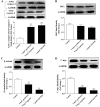Detection and clinical significance of circulating tumor cells in patients with nasopharyngeal carcinoma
- PMID: 31452741
- PMCID: PMC6676596
- DOI: 10.3892/ol.2019.10560
Detection and clinical significance of circulating tumor cells in patients with nasopharyngeal carcinoma
Abstract
Nasopharyngeal carcinoma (NPC) is the most common cancer type originating in the nasopharynx, and varies notably from other cancer types of the head and neck in its occurrence, causes, clinical behavior and treatment. Significant effort has been made into understanding the biological properties of circulating tumor cells (CTCs), with previous studies demonstrating the critical role CTCs serve in the metastatic spread of carcinoma. However, associations between NPC and CTCs have not been completely elucidated. Therefore, in the present study, the CanPatrol™ CTC-enrichment technique and classical in situ hybridization assay were utilized to acquire, identify and classify CTCs from patients with NPC. Subsequently, the correlation between CTCs and the clinical indexes, progression-free survival (PFS), N-cadherin gene expression and the response to therapy were investigated. The present study then determined whether the Wnt/β-catenin signaling pathway served a role in therapy for NPC cells. Collectively, the research demonstrated that CTCs could be detected in patients with NPC. Additionally, CTCs exhibited a statistically significant association with the Epstein-Barr virus infection prior to therapy and Eastern Cooperative Oncology Group score following therapy. Furthermore, co-treatment with cisplatin and paclitaxel significantly decreased the number of CTCs. In addition, mesenchymal CTCs may serve as a predictor of PFS. Finally, the present study demonstrated that cisplatin combined with paclitaxel induced apoptosis and decreased the tumor markers in NPC cells through the Wnt/β-catenin signaling pathway. In conclusion, these data indicated that CTCs may serve as a biomarker in monitoring the therapeutic efficacy of treatments for NPC. Furthermore, the Wnt/β-catenin signaling pathway served a therapeutic role in the treatment of NPC.
Keywords: CanPatrol™ CTC-enrichment technique; N-cadherin; Wnt/β-catenin signaling pathway; circulating tumor cells; nasopharyngeal carcinoma.
Figures





References
LinkOut - more resources
Full Text Sources
Research Materials
